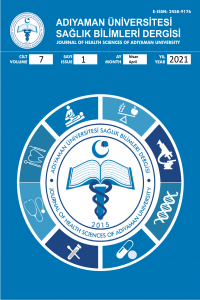Postmenopozal Kadınlarda Balık tüketiminin Kemik Mineral Yoğunluğu Üzerine Etkisi
Osteoporoz, menopoz, kemik mineral yoğunluğu
Effect of Fish Consumption on Bone Mineral Density in Postmenopausal Women
Osteoporosis, menopause, bone mineral density,
___
- Riggs, B.L.; Melton, L.J., 3rd. The worldwide problem of osteoporosis: Insights afforded by epidemiology. Bone 1995, 17, 505–511.
- Li X, Lei T, Tang Z, Dong J.Analyzing the association between fish consumption and osteoporosis in a sample of Chinese men. Journal of Health, Population and Nutrition. 2017; 36(1):13.
- Li Z, Fava SL, Otvos J, Lichtenstein AH,Carrasco WV, McNamara JR, Ordovas JM,Schaefer EJ. Fish Consumption Shifts Lipoprotein Subfractions to a Less Atherogenic Pattern in Humans. J. Nutr. 134: 1724–1728, 2004.
- Cashman, K.D. Diet, nutrition, and bone health. J. Nutr. 2007,137(11),2507–2512.
- Park H, Heo J, Park Y. Calcium from plant sources is beneficial to lowering the risk of osteoporosis in postmenopausal korean women. Nutr. Res. 2011, 31, 27–32.
- Tartibian B, Hajizadeh MB, Kanaley J, Sadeghi K. Long-term aerobic exercise and omega-3 supplementation modulate osteoporosis through inflammatory mechanisms in post-menopausal women: a randomized, repeated measures study. Nutr. Metab. 2011; 8:71.
- Caughey GE, Mantzioris E, Gibson RA, Cleland LG, James MJ. The effect on human tumor necrosis factor alpha and interleukin 1 beta production of diets enriched in n-3 fatty acids from vegetable oil or fish oil. Am. J. Clin. Nutr. 1996, 63, 116–122.
- Coetzer H, Claassen N, van Papendorp DH, Kruger MC. Calcium transport by isolated brush border and basolateral membrane vesicles: Role of essential fatty acid supplementation. Prostaglandins Leukot. Essent. Fatty Acids 1994, 50, 257–266.
- Baggio B, Budakovic A, Nassuato MA, Vezzoli G, Manzato E, Luisetto G, Zaninotto M. Plasma phospholipid arachidonic acid content and calcium metabolism in idiopathic calcium nephrolithiasis. Kidney Int. 2000, 58, 1278–1284.
- Atar HH, Alçiçek Z. Su Ürünleri Tüketimi ve Sağlik. TAF Preventive Medicine Bulletin 2009;8 (2):173-176. Parhami F, Alan Garfinkel A, Linda L. Demer. Role of Lipids in Osteoporosis. Arteriosclerosis, Thrombosis, and Vascular Biology. 2000;20:2346-2348.
- Aydın H, Dilek MK, Aydın K. Trends in Fish and Fishery Products Consumption in Turkey. Turkish Journal of Fisheries and Aquatic Sciences 2011;11:499-506.
- Zalloua PA, Hsu YH, Terwedow H, et al. Impact of seafood and fruit consumption on bone mineral density. Maturitas, 2007;56:1–11.
- Braxton DM, Candace MK, Jennifer LS, Reina P, Richard LB. Genetic and environmental determinants of bone mineral density in Mexican Americans: results from the San Antonio Family Osteoporosis Study. Bone 2003;33(5):839-846.
- Choi E, Park Y. The Association between the Consumption of Fish/Shellfish and the Risk of Osteoporosis in Men and Postmenopausal Women Aged 50 Years or Older. Nutrients 2016;8:113.
- Zalloua PA, Hsu YH, Terwedow H, Zang T, Wu D, Tang G, et al. Impact of seafood and fruit consumption on bone mineral density. Maturitas 2007, 56, 1–11.
- Chen, Y, Ho S, Lam S. Higher sea fish intake is associated with greater bone mass and lower osteoporosis risk in postmenopausal chinese women. Osteoporos. Int. 2010, 21, 939–946. Farina, E.K.; Kiel, D.P.; Roubenoff, R.; Schaefer, E.J.; Cupples, L.A.; Tucker, K.L. Protective effects of fish intake and interactive effects of long-chain polyunsaturated fatty acid intakes on hip bone mineral density in older adults: The framingham osteoporosis study. Am. J. Clin. Nutr. 2011, 93, 1142–1151. Hannan MT1, Felson DT, Dawson-Hughes B, Tucker KL, Cupples LA, Wilson PW, Kiel DP. Risk factors for longitudinal bone loss in elderly men and women: the Framingham Osteoporosis Study. J Bone Miner Res. 2000;15(4):710-20.
- Virtanen, J.; Mozaffarian, D.; Cauley, J.; Mukamal, K.; Robbins, J.; Siscovick, D. Fish consumption, bone mineral density, and risk of hip fracture among older adults: The cardiovascular health study. J. Bone Miner. Res. 2010, 25, 1972–1979.
- Mahaffey, K.R. Fish and shellfish as dietary sources of methylmercury and the ω-3 fatty acids, eicosahexaenoic acid and docosahexaenoic acid: Risks and benefits. Environ. Res. 2004, 95, 414–428.
- Virtanen JK, Mozaffarian D, Cauley JA, Mukamal JK, Robbins J, Siscovick DS. Fish Consumption, Bone Mineral Density, and Risk of Hip Fracture Among Older Adults: The Cardiovascular Health Study Journal of Bone and Mineral Research, 20102;9:1972–1979.
- Yayın Aralığı: Yılda 3 Sayı
- Başlangıç: 2015
- Yayıncı: ADIYAMAN ÜNİVERSİTESİ
Bupropion Kullanımına Bağlı Asemptomatik Transaminaz Yükselmesi: Olgu Sunumu ve Literatür Taraması
Osman Hasan Tahsin KILIÇ, İhsan AKSOY, Bahadır DEMİR
Muhammet Zeki GÜLTEKİN, Ender ALAGÖZ, Serdar YÜKSEL, Şule ÖZSOY, Ali AVCI, Mehmet Akif GÜLEÇ, Oğuz UĞUR
Barsak Obstrüksiyonu Bulguları ile Başvuran Pediatrik Meckel Divertikülit Olgusu
Mehmet ŞİRİK, Musa ABEŞ, İbrahim İNAN, Hasan Öğünç APAYDIN, Ali Haydar BAYKAN, Safiye KAFADAR
NORMAL KARACİĞER, BÖBREKLER VE DALAK PARANKİMİNİN ORTALAMA ADC DEĞERLERİNİN HESAPLANMASI
Safiye TOKGÖZ ÖZAL, Şükrü Mehmet ERTÜRK
Postmenopozal Kadınlarda Balık tüketiminin Kemik Mineral Yoğunluğu Üzerine Etkisi
Derin Anemi Nedeniyle Hastanede Yatan İnfant Hastaların Etiyolojik Açıdan İncelenmesi
